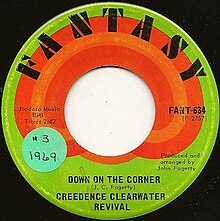Loading AI tools
1969 single by Creedence Clearwater Revival From Wikipedia, the free encyclopedia
"Down on the Corner" is a song by the American band Creedence Clearwater Revival. It appeared on their fourth studio album, Willy and the Poor Boys (1969). The song peaked at No. 3 on the Billboard Hot 100 on 20 December 1969. The flip side, "Fortunate Son", reached No. 14 on the United States charts on 22 November 1969, the week before Billboard changed its methodology on double-sided hits.[4]
| "Down on the Corner" | ||||
|---|---|---|---|---|
 | ||||
| Single by Creedence Clearwater Revival | ||||
| from the album Willy and the Poor Boys | ||||
| A-side | "Fortunate Son" | |||
| Released | October 1969 | |||
| Recorded | 1969 | |||
| Genre | ||||
| Length | 2:47 | |||
| Label | Fantasy | |||
| Songwriter(s) | John Fogerty | |||
| Producer(s) | John Fogerty | |||
| Creedence Clearwater Revival singles chronology | ||||
| ||||
In Canada, the single reached No. 4 in December 1969,[5] and No. 5 in New Zealand.[6] The song performed better in much of Continental Europe, where it made number 2 in Germany, number 9 in Austria, number 8 in the Netherlands, number 17 in Flemish-speaking Belgium and number 6 in French-speaking Belgium[7] than in the United Kingdom, where it stalled at number 31.[8]
The song depicts the fictional band Willy and the Poor Boys, and how they play on street corners to cheer people up and ask for nickels.
Songwriter John Fogerty explained how the lyrics were derived:[9]
[I] was kind of inspired by seeing an advertisement in the paper one day. It was an ad from Disney that said in great big letters 'Winnie the Pooh'. Something in my brain said 'Winnie the Pooh and the Pooh Boys'. Obviously, that was close to 'Willy and the Poor Boys'. As I began to develop this idea it turned into music in that weird mystical, almost uncontrollable way, music comes to songwriters. Winnie the Pooh is still my favorite character who I've shared with my daughter Kelsy since the day she was born, though she's growing out of it. But I'm not.
The song makes reference to a harmonica, washboard, a kazoo, a Kalamazoo guitar, and a gut bass.[10] In a 1969 appearance on The Music Scene,[11] the band performed the song dressed up as "Willy and the Poor Boys".[12] Stu Cook played a gut bass, Doug Clifford the washboard, and Tom Fogerty the Kalamazoo, which mimicked the appearance of the band as they appear on the album cover.
Billboard described the single as having "an infectious calypso beat".[13]
| Region | Certification | Certified units/sales |
|---|---|---|
| New Zealand (RMNZ)[14] | 2× Platinum | 60,000‡ |
| Spain (PROMUSICAE)[15] | Gold | 30,000‡ |
| United States (RIAA)[16] | 2× Platinum | 2,000,000‡ |
|
‡ Sales+streaming figures based on certification alone. | ||
Seamless Wikipedia browsing. On steroids.
Every time you click a link to Wikipedia, Wiktionary or Wikiquote in your browser's search results, it will show the modern Wikiwand interface.
Wikiwand extension is a five stars, simple, with minimum permission required to keep your browsing private, safe and transparent.